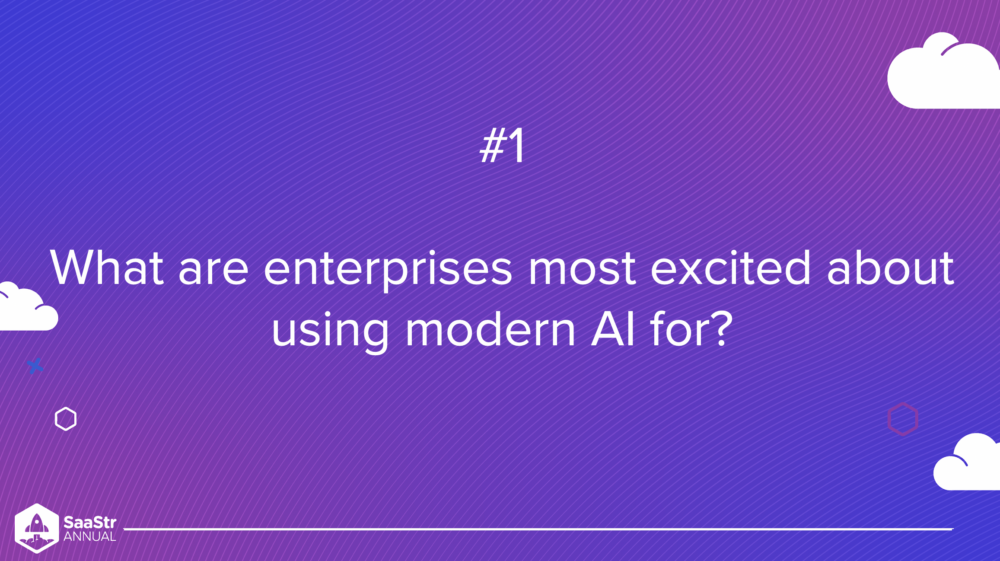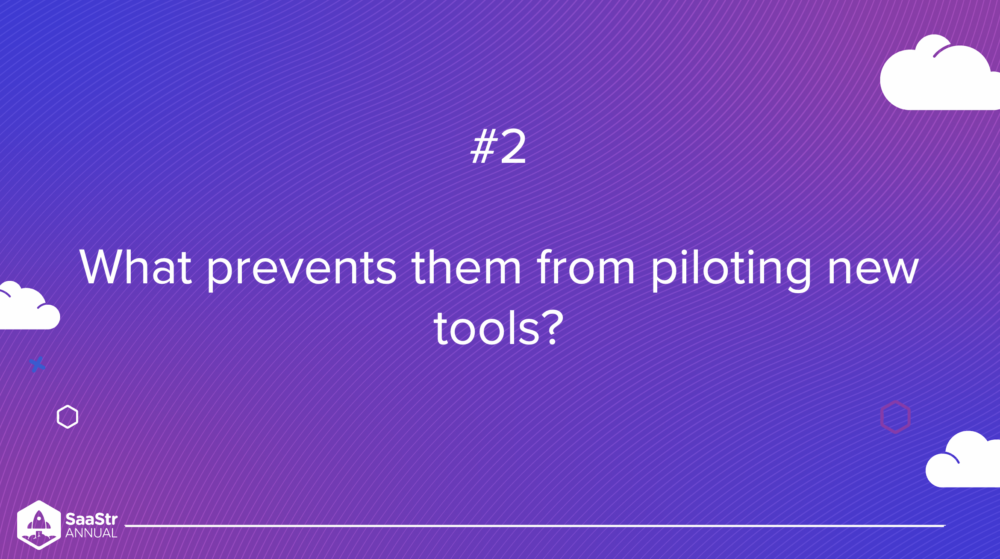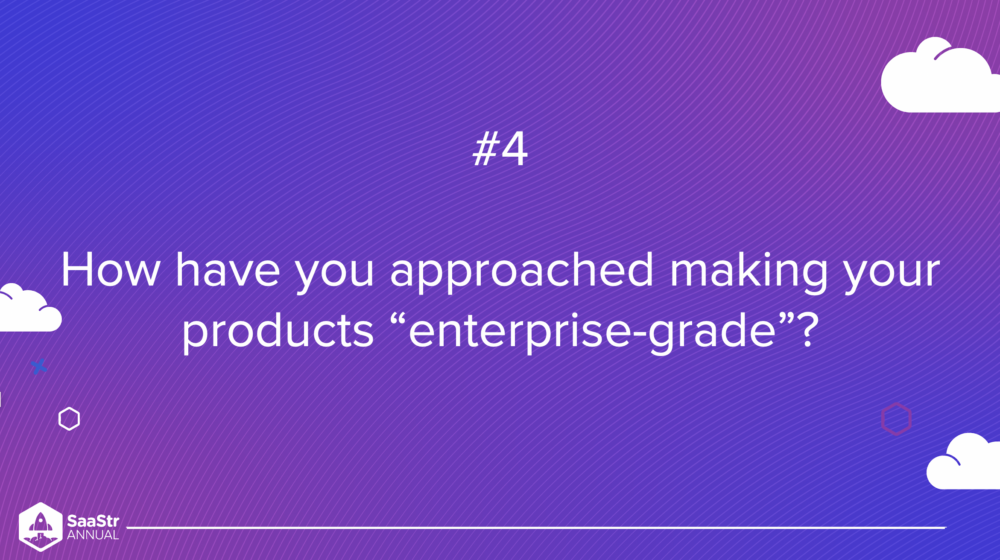At Saastr Annual, we hosted an Enterprise panel of AI leaders to share their experience and knowledge to help others understand how big companies think about and leverage AI. Sure – the rise of ChatGPT has gone mainstream for consumers and smaller companies, but what about the big guys? While the first generation of Generative AI is great, it’s not quite ready to solve Enterprise problems. So, where are we now in the adoption cycle for the Enterprise world?
In this session, we brought together:
- Douwe Kiela, CEO of ContextualAI
- Benjamin Mann, co-founder of Anthropic
- Arvind Jain, CEO of Glean
- and Sandhya Hedge, General Partner at Unusual VC,
To help us figure out how to sell GenAI software to some of the biggest organizations in the world.
What Are Enterprises Most Excited About Using AI For?

As our panelist have all worked with Enterprise companies (ie Amazon, Google, Salesforce, etc.), they’ve all seen a level of excitement that they’ve never witnessed before when it comes to AI. Enterprises are looking for two big themes.
- They want to use AI to improve the products they sell to their customers.
- They want to use AI to transform their business and how they and their employees work.
Some of the biggest use cases for AI in the enterprise are across customer support, sales and marketing, and engineering — ie helping developers test code and troubleshoot issues. On top of that, these AI experts were impressed with how the largest companies in the world, not just software companies, but even more consumer-facing enterprise-sized companies like banks and retailers, are rolling forward with AI.
Benjamin Mann, co-founder of Anthropic added: “For example, one large bank that we were talking to came to us and said, ‘we’ve talked to everybody in our company, and we have 500 different use cases that we want to apply large language models to.’ That’s really incredible. And they don’t even know where to start. So working with us to say what can they do today? And then Beyond that, how can they make AI an expert in what their product is so that their customers don’t have to go read all their documentation, but instead, just talk to an AI as if it was a solution architect or forward deployed engineer and be able to use the product immediately.”
Everyone knows AI has already changed the way we work. At the same time, you can see in many Enterprises that a lot of people are excited about that change but aren’t sure what it exactly looks like yet. And that’s what everyone is trying to discover — where the tech will matter most, where it’s ready, and where it’ll be ready soon.
Enterprise Use Case Buckets for AI
If you look at the landscape of use cases right now, Douwe Kiela, CEO of ContextualAI, explained that there are essentially three big buckets:
- Info discovery and info synthesis — how do I get deeper insights and not just data?
- Hierarchical summarization — how do I turn it into something I can act on?
- Support chatbots
95% of all use cases usually fall into one of these buckets, and within those buckets, companies are trying to figure out what they want to do.
Douwe added: “For us the best use case is one where you can define what success looks like. And we see surprisingly few of those kinds of use cases actually. It’s more ‘Oh, this technology is great. I want to try it on my chatbot.’ When we ask people, how do you define success? How are you going to measure that this thing is actually good enough for a production deployment? Very often, they don’t have a good answer. That’s really one of the things that we’re looking for first. Do you actually understand what you want?”
What are the Biggest Barriers to Adoption in Enterprise?

Specifically in the Enterprise, what have our panelists seen actually hold up or lose deals over when it comes to AI?
- Security – having their proprietary data leave the model and go out into the open markets
- Safety – maintaining or having to establish constant monitoring of the data
- Internal data governance – losing it as you consolidate into a single AI tool or model
- Hallucination — models that make things up
- Attribution problems — being able to trace it back to the training data
- Compliance issues — forgets things or can’t update things easily
- FOMO – What if this model isn’t as good as someone else’s in 2 weeks?
“The most sensitive customers want things like FedRAMP certification and things that take multiple years and a ton of effort to implement,” Benjamin Mann, co-founder of Anthropic added. While they’ve been able to navigate around this by partnering with Amazon’s Bedrock program, this won’t work for all.
And finally, another barrier to Enterprise adoption is the additional bandwidth required to implement it – successfully.
Benjamin added, “I think a lot of people think about this new AI technology as something that’s gonna just come in and like work from day one. But actually, it turns out its still software. And with software, you need to do the work of doing the user research and iterating with all your different teams. In our case, Notion is a great example where we worked very closely with their CTO and everybody all the way down to their engineers on the front lines to deeply integrate Anthropics AI into the notion product experience, and we think it’s extremely good. But it was, it needed a lot of dedication to make that happen.”
Who are the Early Adopters of AI in Enterprise?
Early adopters so far in the Enterprise, maybe to no surprise are typically very tech-forward companies but also big banks and retailers. Other early adopters might be software Enterprises that are now big, and they’re facing the barriers listed above. CIOs often lead the charge because they represent the demands of the entire company. Salespeople, marketing, HR, and engineering all want the tech, so the CIO has become the focal point to bring a product in.
Douwe Kiela, CEO of ContextualAI summarized it best by saying; “I think you tend to have very tech-forward companies that are basically just ready to go, but very often they think they can do it in-house. And so I think that belief is probably going to go away in the next couple of years when people realize that this stuff is a little bit more difficult than they initially thought. But so aside from that, I think one of the interesting things that we’re seeing is that there’s really a mandate from the CEO down. Where it’s we have to do something and so to me, that’s exciting because it’s a business opportunity.”
What are the Most Important Investments that Ensure a Future 50 Company Can Adopt?

Compliance matters. Security matters. And in the beginning, since AI is handling so much data – trust is fundamental.
Arvind Jain, CEO of Glean explained: “The first thing is just working on all security aspects and compliance. So getting your SOC-2 certification, HIPAA compliance, GDPR, and FedRAMP. That’s one stream of, enterprise requirements, which is, just needing all these compliance matters. On top of that, in terms of product, depending on what your product is, there’s going to be a lot of demands that Enterprises are going to place on you.”
Entperises aren’t just going to share all their data with one day one – so being able to either layer the AI into their existing data environment or use frameworks on Amazon and Google can help eliminate the need to go through extensive procurement and additional security audits. The future of these large language models will be solving the barriers of language hallucination and data attribution, being trustworthy, and understanding your brand voice and what your company is about.
Does Fine-Tuning Offer a Competitive Advantage?
Since media coverage of AI is so heavy these days, many folks come to ContextualAI, Anthropic, and Glean with a lot of expectations off the bat.
Many don’t understand what they want out of fine-tuning. They just hear about it and think it’s a way to get a competitive edge. However, there are better forms of tech coming out and Douwe Kiela, CEO of ContextualAI laid it out best: “We see this a lot actually where customers just go, we want to fine-tune our model, Can you help us with this? And so what we tell them is you’ve probably been lied to. You don’t have to fine-tune your model.”
Douwe added: ” You really shouldn’t need it. You can probably just solve that problem through retrieval augmented generation, or by having a very long context window. The only case where you can need it is if you want it to support a use case where you have a lot of data that nobody else has and it’s really specific to that use case.”
A Round of Predictions about AI for 2024-2030
Sandhya closed the session by asking, “What is something wild and something realistic you hope will be true in 2030?”
For Arvind at Glean, he had a practical hope that we all would have a truly smart, knowledgeable personal assistant who would do most of our work for us by 2030. Today, that luxury is limited to executives in Enterprises. In the future, it will be for all of us.
For Ben at Anthropic, the bright future involves language models understanding us better than we understand ourselves. When we ask it to do things for us, it’ll do what we mean and not what we say. Ideally, AI will make us all better people, improve our relationships, and help us be the best version of ourselves. What will it actually be? Maybe 60% of that, which would still be great.
For Douwe at ContextualAI, he believes technology has a lot of potential to do good. 2030 will be a different place, so he hopes by then that AI will do all “boring, mundane stuff” so we can be more creative and do the things we enjoy.

